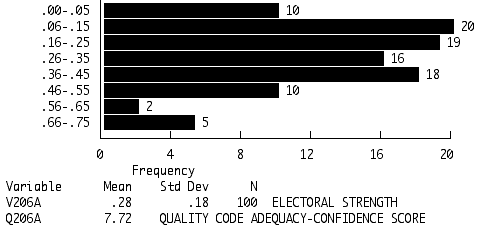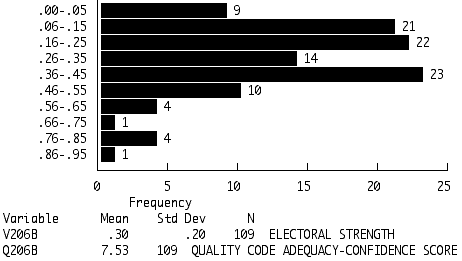|
|||||||||||||
|
cial problems in disentangling votes cast for coalition candidates at the legislative level. There are some data availability problems in focusing on legislative elections in determining electoral strength, for national totals tend not to be reported for legislative elections when there is a presidential election to upstage the campaign--which is characteristic in Latin America. In this event, percentage results for presidential elections are used in preference to the absence of electoral data. Operational Definitions. Electoral strength is expressed by the party's proportion of the total vote cast in national elections for the lower house of legislature (or elections for president, if the former data are not available), averaged over the number of elections held. This calculation is made by the computer from data that the coders recorded on electoral data sheets for the proportion of votes cast (see Chapter 13). If a party failed to gain votes in a given election due to banning, boycotting, or invalidating of results, those elections are excluded from the computation of electoral strength, which is then based on the remaining elections for which the plausible data exist. Coding Results. Scores for BV206 assumed values from 0 to .89; they are reported in grouped form in Tables 4.6a and 4.6b. Note that this distribution differs from that of "legislative strength" by being unimodal and relatively symmetrical. The basic difference between the two is that parties that held no legislative seats--for whatever reason--were coded 0 for BV205, whereas parties that won no votes--because of ban, boycott, or invalidation of ballots--were treated as missing data for BV206. Parties that eliminated their electoral competition and thus averaged over 90 percent of the votes were also excluded from scoring for their "electoral strength." Thus only about two-thirds of the parties were coded as having "valid cases" for electoral strength in either part of the period. Moreover, the quality of the data for those coded was generally lower, although there again was no significant relationship between the BV and AC codes.
TABLE 4.6a: Early 1960s: BV2.06R Electoral Strength, Recoded
Duverger stressed the importance of the parliamentary or extraparliamentary origin of political parties in accounting for the centralization of power within the party and the influence of parliamentary members on party activities. Since his writings in the early 1950s, the locus of party origins has drawn more attention for its relationship to governmental status. LaPalombara and Weiner write, "Externally created parties are those that emerge outside the legislature and invariably involve some challenge to the ruling group and a demand for representation. Such parties are more recent phenomena; they are invariably associated with an expanded suffrage, strongly articulated secular or religious ideologies, and, in most of the developing areas, nationalistic and anticolonial movements" (1966, p. 10). Although the "outside origin" variable has been advanced as a relevant and important indicator of governmental status--and was originally considered as such at |
|||||||||||||

